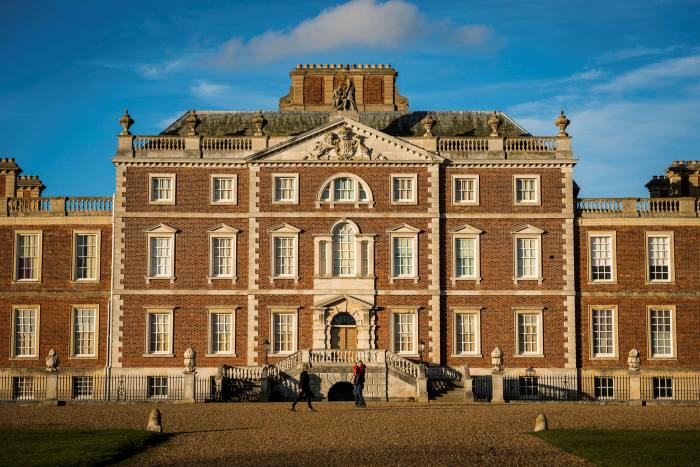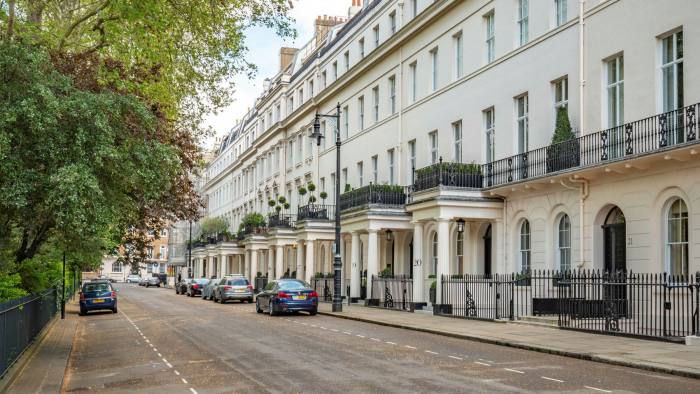Lymm Hall is an Elizabethan manor house built in 1603. It is Grade II* listed, making it among England’s most protected properties and creating a problem for its owner Kit Knowles, who is attempting to bring the hall up to modern standards of energy efficiency.
“We have an incredibly effective guide for creating high-performance buildings. But there are a lot of issues with applying that to historic buildings,” says Knowles, who runs Ecospheric, which works on pioneering sustainable development projects. Lymm Hall is a test bed for the company’s work to retrofit historic properties and, ultimately, will be a home for Knowles and his family too.
The house, in Cheshire, has some very particular issues: “It has a cockfighting pit, a moat and an icehouse, each protected in their own right,” Knowles says.
While some of the challenges at Lymm Hall are unique, the problem of how to make old buildings more energy efficient and end their reliance on polluting heating systems cascades through the UK’s property market. And it is a problem that must be solved if the UK is to meet its goal of achieving net zero greenhouse gas emissions by 2050.
“The UK has the oldest housing stock in Europe, and most likely in the world,” according to a report by the BRE Trust, a charity. Buildings are the UK’s second-largest source of greenhouse gas emissions, accounting for nearly a fifth of the total. Most are generated by fossil fuels burnt for heating — largely gas. These heating systems also add to air pollution, which contributes to a host of diseases including cancers.
Generally, older homes are worse offenders, with poorer insulation, thinner windows and draughty chimneys. Roughly 5m English homes, just under a fifth of the national stock, were built before 1919, according to the English Housing Survey. A wave of house building prompted by the industrial revolution is still in evidence, with terraces common in city centres from Manchester and Liverpool to London and Oxford.
“People fall in love with [old homes] and regret them by the first Christmas,” says Knowles. “They come to us with health conditions, concerns about the carcinogenic effects of their homes and bills. They say: ‘I’ve got a building that’s costing me £10,000 a year in electricity, how can I address that?’”
Addressing it is not always straightforward, says Philip Harvey, senior partner at buying agency Property Vision. “With planning rules, of course you can’t just go whacking an air source heat pump where you like,” he says. “Sometimes with listed buildings and conservation areas you have to be very careful. There’s so many hoops to fight through that’s it’s so much easier for people to throw their hands up and stick with what they have got.”
The problem is particularly acute with listed buildings such as Lymm Hall, which are wrapped in layers of protections that govern everything from fitting new windows to stripping paint or replacing door handles.
Owners of listed buildings may find they need to apply for listed building consent from their local planning authority on top of traditional planning permission. The application process and requirements are different for each permission, and in some cases listed building consent must be granted by the secretary of state, according to Historic England.

There are roughly 500,000 listed buildings in England, according to Historic England, the body that oversees their classification. More than 90 per cent of those are Grade II listed, meaning there is relatively wide scope for amending them. But about 6 per cent are Grade II* listed and 2.5 per cent are Grade I listed, with far tighter regulation.
“We can turn nearly any building in the world into a Passivhaus [a standard for highly-insulated, energy-efficient homes] unless it’s listed,” says Knowles.
How homeowners, ministers and heritage groups square that circle will have an important bearing on the country’s success in hitting increasingly urgent climate targets and on the fate of some of the UK’s cherished historical homes.

After much delay, the UK government this month published its plans for decarbonising the economy, which included a road map for buildings. By the mid-2030s, ministers hope, about 13m of the UK’s 29m homes will be fitted with low-carbon heating systems such as electric heat pumps.
But the government did not say exactly how this will happen, or who will pay for it. The Treasury is stumping up £450m to encourage the installation of heat pumps over the next three years, but the £5,000-per-household grant is significantly below the cost of installing one. Heat pump installations typically cost about £10,000 for residential homes — but can run into the hundreds of thousands for larger properties.
Here, too, the oldest properties are likely to be the hardest to wrench into modernity. Fitting a very large historic mansion with heat pumps can cost “up to half a million [pounds],” which will include any additional work that needs doing to upgrade the pipework, radiators and heating controls, says Lizzy Carlyle, head of climate and environment at the National Trust.
So far, the National Trust has installed 71 heat pump systems in its buildings, including at the Wimpole Estate in Cambridgeshire, and nearly half of the group’s heat and power now comes from its own renewable sources, including solar panels.

“We’re pretty confident in the tech and how we can make it work with those historic buildings,” says Carlyle. Work has been funded in part by the revenue generated by the Trust’s renewable energy projects.
Many of those buildings had previously run on oil since they had not been connected to the gas grid — including Wimpole, which used about 35,000 litres a year. Relying on the thick, polluting fuel “caused us big problems . . . We’ve had some significant oil spills,” says Carlyle.
For very large properties that require temperatures to be kept constant — needed to preserve historic collections and avoid books, furniture and fabrics being damaged — the Trust might install two heat pumps to ensure there is a back-up if one fails.
Although the units can be large, they are no bigger than the oil-heating systems they are replacing, says Carlyle. “All of our mansions have to accommodate modern infrastructure. This is just one piece of it,” she says.
However, listing rules mean that not all interventions, such as swapping single-glazed windows for less draughty double or triple glazing, are possible.
“The heritage sector recognises importance of sensitively adapting historic buildings and structures to save energy and reduce our carbon footprint,” says Duncan Wilson, chief executive of Historic England. “The question is not whether we do it, but how we do it.”
It is better to maintain, and perhaps double glaze, historic windows than install new UPVC units, for example, he says. Historic buildings can also have in-built advantages, such as thick walls that keep them cool in the summer without using energy, he adds.
Respecting heritage in such projects is important, says Tor Burrows, sustainability director at Grosvenor Britain & Ireland, which owns large chunks of Mayfair and Belgravia in central London as part of a nationwide portfolio of homes, shops and offices. But it should not be done “at all costs”, she says. “We’re in an emergency, we need to strike a balance.”

In Westminster, which is dotted with centuries-old, heavily protected buildings, the built-environment accounts for as much as 85 per cent of direct emissions, Burrows says.
Grosvenor is midway through a £90m retrofit programme to rein in emissions, focusing on replacing gas boilers, limiting draughts and switching to LED lighting. Burrows estimates the cost at £33 per square foot. “It’s clear that retrofitting buildings costs money, I don’t think anyone should shy away from that,” she says. The government should make funds available for those least able to fund the transition, particularly owners of listed social housing blocks, and work to align planning policy, listing rules and sustainability targets, she says.
One of the biggest challenges is the patchwork of rules governing planning, which mean that retrofit projects that are permissible in one local authority might be forbidden in the neighbouring council, she adds.
For anyone planning to improve the energy efficiency of a historic home, the critical thing is to be sensitive to the building’s needs. “To do it right, you really need to understand the context of the building now, and that’s quite difficult,” says Peter Draper, director of the Sustainable Traditional Buildings Alliance. That includes how its layout and use has changed over time and, crucially, whether sources of moisture such as bathrooms and central heating have been introduced.
“The vast majority of where things go wrong and the vast majority of risks are all based around moisture,” he says.
To get the most out of a heat pump, experts recommend that properties be well insulated and energy efficient. But that can pose a challenge for the owners of old buildings, who face restrictions on what they can change.
For virtually all listed buildings, “there’s generally nothing you can do on the outside,” says Draper. “[Adding] external wall insulation is probably not going to be a goer”, since making changes to its appearance is unlikely to be permissible.
Loft, underfloor and internal wall insulation may be possible. But internal wall insulation can be “really risky”, he says: padding the downstairs and the upstairs walls can leave a cold spot between the floors, which may gather moisture. If old timber joists are supporting upper floors, they could get damp, and “timber and moisture don’t go very well together”, says Draper.
Doing work that you might do to a modern building to an old one can have unintended and problematic consequences. “Old buildings were designed to breathe, so it’s vital that you don’t start sealing them up,” says Bean Beanland, director for growth and external affairs at the Heat Pump Federation. Sealing them will trap moisture and cause condensation problems and mould, he says.
Installing insulation beneath the roof or floors of an old building, without changing the appearance of the structure, can be painstaking work. Individual stone slabs or roof tiles might be mapped out and numbered before they are removed and then carefully replaced in the right order, says Beanland. “It’s very labour-intensive.”
When Neil Blackley rebuilt his cottage in Hampshire in 2010, he had ambitions beyond the two heat pumps he installed. He added solar panels, installed LED lighting and reorientated the windows so they caught the arc of the winter sun for warmth but missed the summer rays, keeping the rooms cool. “You have to look at the house holistically,” he says.
Aiming for such high environmental standards “made it massively more complicated and expensive”, he admits. But the total outlay of roughly £30,000 on solar panels and the heat pump have largely paid for themselves, thanks to subsidies and energy bill savings, he says.
According to Knowles, the cost of attaining the Passivhaus energy-efficiency standard ranges from £60,000 for a three-bedroom semi-detached home to about £1m on an estate. The payback is a sizeable reduction in heating demands and health benefits, he says.
The ideal time to undertake such work is immediately after purchasing a new home, says Harvey. “When you buy a house it’s an ideal opportunity to assess your green credentials. You will buy it, put your mark on it quickly and then probably not touch it for a decade.”

A growing number of clients are filtering their searches on the basis of a home’s energy performance, he says. “Houses that don’t meet green criteria are going to be less desirable, that’s a simple fact,” he adds.
While retrofitting can be complex and costly, an ambitious project in Somerset demonstrates what is possible. Bath Abbey, a Gothic church that has stood for centuries, has an unusual new feature: underfloor heating.
The multimillion-pound job was completed in March, and draws heat into the Abbey from the 1.1m litres of 40C thermal spring water that flows each day through the drain from the nearby Roman baths.
The work was laborious: the Roman drain’s humid and confined environment meant that engineers could only work in 20-minute stints, with longer periods deemed unsafe. The equipment, meanwhile, had to be lowered 7m down to the floor of the drain through a manhole cover in the street.
The system was made possible as a result of the need to renovate the Abbey’s floor — which had been gradually sinking as a result of huge voids in the earth caused by thousands of church burials that had taken place on the site.
The floor had to be taken up stone by stone — with all 891 then carefully replaced. But that provided a prime opportunity to do some additional below-ground work: installing modern, carbon-free heating.
Funding came in large part from a £10.7m grant from the National Lottery Heritage Fund, with the heating system upgrade part of a broader slate of work to restore the building and reduce its carbon footprint.
Most retrofit jobs will come nowhere near that price. Knowles says that even bringing a home up to Passivhaus standards could cost less than what he calls the “Grand Designs-inspired renovation”, referring to the UK TV show’s tendency to encourage homeowners to embark on their own ambitious building projects, be they new kitchens, new living rooms, or even great glass extensions.
But in any case, the price of the works can seem secondary to the desire not to contribute to the climate emergency we are all facing: people are deeply concerned about the future. “That’s why I’m doing it,” Knowles says. “I’ve got three kids.”
George Hammond is the FT’s property correspondent; Camilla Hodgson is an FT climate reporter
Follow @FTProperty on Twitter or @ft_houseandhome on Instagram to find out about our latest stories first
Credit: Source link










